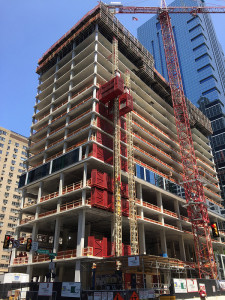
The concrete structure on the 1919 Market St. Apartments project in Philadelphia progresses along on a three-day cycle.
The safety of our employees, other team members on the site as well as the public has always been one of our top concerns. It’s where we have put our focus and energy since our business was founded more than 45 years ago.
With the advent of larger jobs, more stringent requirements from insurance agencies, as well as tighter schedules, many companies have had to revisit their long-standing safety practices.
In addition to having well-trained people, it is important to invest in equipment that keeps all crews safe and maintain that equipment in proper working order. This may sound simple, but in the daily whirlwind of activity, it can easily be forgotten.
A key to success when choosing the right equipment for your projects is having a good relationship with your supplier, as they can provide guidance. Pairing safe operating practices with the equipment is paramount.
Daily inspection is crucial – checking your personal fall arrest systems, ensuring the stitching is intact, no cuts or burns are visible, the snap hook works, and more. These inspections may seem minor, but each can lead to very serious injuries. Another aspect to equipment safety involves the operation of all tools. For instance, making sure all electrical currents are grounded is crucial to prevent shocks, shorting out equipment or electrocution.
Not only is the safety of your workers important, but the safety of surrounding residents or pedestrians on certain jobsites should be taken into consideration. Using safety equipment such as sidewalk canopies for projects alongside walkways or major intersections can ensure people stay protected. In addition, project deliveries involving large trucks require a trained flagger to ensure both pedestrians and drivers are cautious.
To strengthen or revitalize your current safety program, here are a few tips for success:
- Talk with your insurance company and use your resources. With instruction representatives and other professionals available, they can provide the most up-to-date information on the latest equipment safety trends and accident data.
- Be in tune with your clients and what they are looking for on a job-to-job basis. What is important to them as far as your job-specific safety plans and expectations? What will help them make a decision to use you? These are the questions to ask that can help you develop a safety plan that works.
- Create a plan of action to involve your employees and improve your safety conversations. Keeping the communication lines open and listen as much as you teach – the message should go both ways!
Safety has to start at the top and be communicated throughout the organization. Taking a fresh look at safety – from people to equipment and equipment maintenance – can pay huge dividends in terms of keeping all team members healthy, as well as improving productivity. We’d love to hear about your safety tips and how our experience and people can work with you.